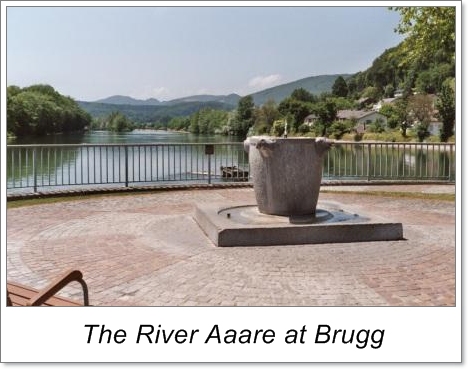
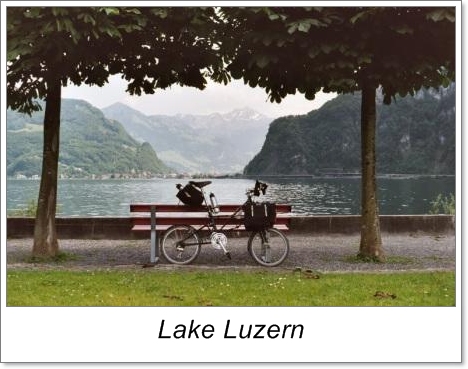
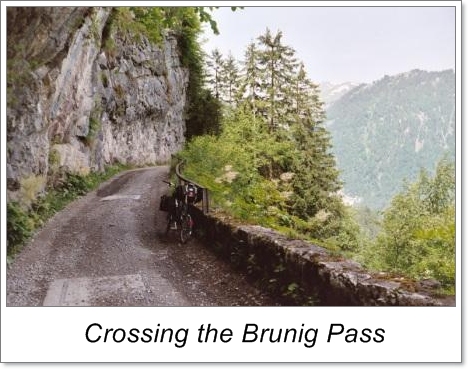
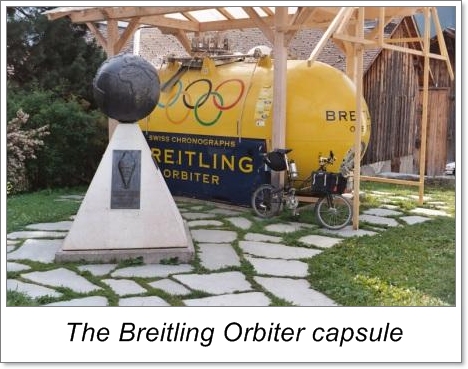
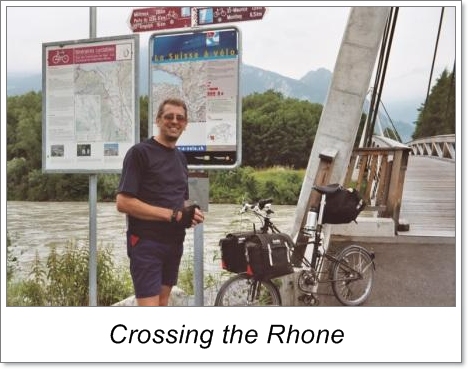
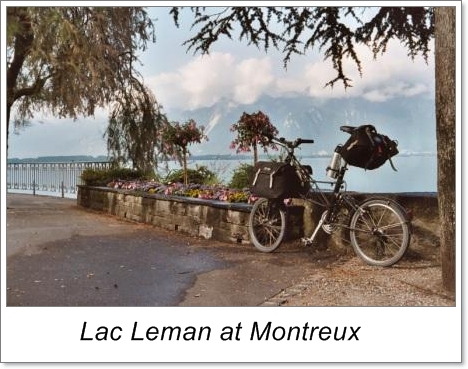
This year I decided to try crossing Switzerland from the Rhine on the northern border and cycle south west to the Rhone valley before heading west to Lake Geneva. The route would be based on linking a number of the national cycle routes, which would give me traffic free cycling through some of Switzerland's finest scenery.
The river Aare is one of Switzerland's major rivers, rising in the Alps and flowing through central Switzerland to join the Rhine about 50k east of Basel at the village of Koblenz, where I started my ride. Northern Switzerland is very much like the Black Forest - rolling wooded hills rising to about 800m, and deep river valleys supporting the local agriculture. Trying to ride across the grain would be hard work but fortunately the Swiss have created the Aare Route (Route 8) which follows the river from its source to the Rhine.
Day 1. Alighting from the train on a June Sunday morning, I was greeted by clear blue skies and temperatures heading for the low 30's. Immediately outside the station was my first Route 8 sign directing me to the Aare. For the next 80k I followed a series of paths along the river banks, switching at times to the opposite bank. These paths varied from gravel paths to quiet paved roads, but at one point I may have strayed onto the walkers' route as I found myself riding on a series of concrete slabs set in the river bank. These slabs were about a meter wide with a wall on one side and the water on the other; one moment's lack of concentration and the unwary cyclist would have had an early bath!
The river at this stage was dammed every few kilometres as part of a large hydroelectric scheme. Consequently the stretches between were wide and slow moving, providing a haven for water fowl. It was easy but hot cycling and the paths were busy with local cyclists enjoying the fine weather. Cycling is far more popular in Switzerland than in the UK and each small town I passed through had its own sports facilities, including running tracks, tennis and volley ball courts, which were very busy with it being Sunday.
My last town on the Aare was Olten, where I left Route 8 and turned south for Zofingen, and my overnight stop at the youth hostel where I had booked a single room.
Day 2. After overnight storms I set off next morning in clearing conditions and the sun soon made an appearance as I headed up the valley on local cycle paths to the next town of Sursee. Here, I stopped at the local bakerei for my morning coffee and cake. No sooner had I sat down when a young woman joined me. She was looking for a folding bike and was interested in my Moulton, so I was able to enjoy a pleasant break discussing small wheeled bikes. This set a pattern which was to continue throughout the week, and I found that the Swiss have few inhibitions about approaching strangers, in fact they seem to go out of their way to make visitors most welcome.
At Sursee I joined Route 3, the North South route, which I had followed last year and would take me to Lucern. I left Sursee on the lakeside path, the first of 9 lakes that I would encounter on this trip. So far I had been riding among wooded rolling hills, but after Sursee the countryside started to change as the views were dominated by the alpine peaks to the south. The route descended to Luzern on dedicated paths along river banks which took me into the heart of the old town. After another visit to a bakerei, I enjoyed lunch in the sun overlooking the old covered wooden bridge that crosses the harbour, with Mount Pilatus dominating the view across the lake.
Leaving Luzern I joined Route 9, the Lakes Route, which crosses Switzerland from Lake Constance in the north east to Lake Geneva in the south west. I would be following the route for the next two and a half days. Following the signposts I headed along the west side of Lake Luzern before turning west along the Alpnach See. Due to the lack of space between the road and the lake, the cycle path was built on boards cantilevered out over the lake. The Swiss go to a great deal of trouble to ensure that there is a rideable cycle path and at one point an avalanche tunnel had been built over the path to safeguard riders from falling rocks.
By mid-afternoon the storms had returned and I was soon engulfed in a downpour as the thunder and lightning rolled in down the valley, but I had to press on to my pre-booked accommodation at Sarnen, only about an hour away. At Alpnach, the route crossed the local airfield, parallel to the runway with only 80m of grass separating me from the runway, no boundary fence, just grass. This is something that would never be permitted in the UK where the authorities are paranoid about security.
Day 3. Next morning the sun was shining into my room, and I could now see the peaks across the valley still carrying the remains of last winter's snow. I was soon on the road following the next lake, the Sarner See. Once round the lake I started what I thought was to be my main climb of the day, the ascent of the Brunig Pass, which at just over a 100m is regarded as quite easy. But about one third of the way up, at the next lake, the cycle route abandoned the motor road and took to gravel tracks around the lake and up into the forest. The lake section was very pretty, with wooden chalets, alpine meadows and views across to the glaciers of the Wetterhorn (3692m), but once in the forest the hard climbing started. A steep off-road section across a ledge cut into the cliff face reduced me to pushing, but I eventually emerged onto the road just below the top. At the summit café a Swiss cyclist on a Dahon called me over and bought my morning coffee while we talked about the merits of small wheeled bikes again. Then it was another steep off-road descent to the town of Meiringen.
Meiringen is quite a mecca for Sir Arthur Conan Doyle fans, and it has its own Sherlock Holmes museum, for just above the town lie the Reichenbach Falls where Holmes fell to his death at the hands of his archenemy, Professor Moriarty. Unfortunately, I had neither the time nor the energy to visit the falls, so I opted for tea and cakes outside the konditorei, which came served on a silver platter with china crockery. I thought that this was quite appropriate for a town with such strong English connections.
From Meiringen the route followed the an ancient pilgrim route, the St Jacobs way, which is part of the route used by pilgrims heading to Santiago de Compostela on Spain's western coast. This section turned out to be as hard as the pass earlier in the day, as the trail climbed high above the Brienzer See and switch-backed across gullies containing impressive waterfalls, before dropping down to Interlaken. After riding through Interlaken I followed easy paths along the banks of the Thuner See to my overnight halt at Spiez, where the hotel overlooked the lake and mountains. It had been a tiring 8 hour day, 96k and 780m of ascent, much of it off road.
Day 4. From Spiez I left the Thuner See and headed up the Simmental Valley. Many people had told me how beautiful this valley was, and in the morning sun it lived up to its reputation. After entering through a narrow rocky gorge, it widened out to meadows complete with chocolate-box chalets surrounded by rocky limestone peaks. The cycle route followed the quiet side of the valley, mainly on paved roads with the occasional stretch of gravel. One interesting feature of this valley was that all the wooded bridges over the river had pitched roofs. I was heading for Zweisimmen for morning coffee, but it was lunch time before I arrived; but perhaps my slow pace was due to the 400m height gain. After lunch I had another climb to the col at the head of the valley (at 1200m), where there were more stunning views across to the glaciers and many of the 3000m peaks of the Bernese Alps. After a short descent I reached Gstaad, which was very picturesque with its traffic free cobbled main street and wooden buildings, so I bought some food and watched the world go by.
My hotel for the night was just another 15k down the valley at Chateau d'Oex, which is a major alpine ballooning centre. The field opposite my hotel was where the Breitling Orbiter was launched on its successful circumnavigation, and the capsule was on display in the town. Although made of kevlar and carbon fibre, it was very basic and cramped inside. It must have been a very cold and uncomfortable 19 days that the crew spent inside.
Day 5. The hotel at Chateau d'Oex was quite upmarket compared to the budget hotels and hostels that I usually stay at; three star rating and a gourmet restaurant, so I decided to treat myself and eat in the restaurant. The other guests consisted of smartly dressed Swiss and French couples, so I thought that I had better dress for dinner, but the best I could manage was to wear some socks with my Ron Hills and tee shirt! The grilled salmon and chocolate mouse where just what I needed to satisfy a voracious appetite. Next morning, at breakfast, while the other couples daintily nibbled at their croissants I tucked into a cyclist's gourmet breakfast: two glasses of orange juice, a bowl of yoghurt, a bowl of muesli, four rounds of bread, ham and cheese, a croissant with jam and an apple, all washed down with two pots of tea! I would be in need of the calories for the day's ride.
At Chateau d'Oex I left Route 9 and turned south to the Rhone valley over the Col du Mosses (1450m). From the hotel to the col was just 15k, and the climbing started immediately. There was no opportunity to warm up and it was difficult forcing stiff and tired muscles to work in uphill mode. After an initial 2k of climbing, the gradient eased, and entered a quiet gorge where the road was cut into the cliff face, with a 100m drop to the river on one side. On exiting the gorge the road entered the forest and the steeper climbing started, but by then I was into the rhythm of climbing, just sit and spin the pedals while the contents of the two pots of tea oozed from every pore on my head. From the top of the col it was just possible to see the glaciers and mountains of the Mont Blanc massif on the other side of the Rhone valley. Then it was into one of those fabled descents that we have all read about, 16k without turning the pedals. The road snaked down the mountain side on wide smooth tarmac, and the absence of traffic enabled me to swoop round the hairpins using all the road.
Once in the Rhone valley I stopped at Aigle for lunch, but at this point I had cycled off my maps. I knew I had to continue south and cross the motorway and river, but all roads out of town seemed to lead me onto the motorway or dual carriage ways, so I ended up following the only main road with cycle paths. Sure enough, it took me in the right direction to join Route 1, the Rhone cycle path. It was now easy cycling along the river bank to Lake Geneva, and then along the lake shore to the YH at Montreux. The hostel was in an ideal location, purpose built, and on the lake shore not far from the town centre. So after a meal at the hostel I joined the smart set for a stroll along the promenade.
Day 6. Montreux marked the end of the serious cycling, as next day I had only 30k to cover to Lausanne. The marked route tends to follow the main road, but as this area is known as the Swiss Riviera, I abandoned the road in favour of following the promenades along the lake shore, exploring the harbours and whiling away a couple of hours in the sun at various cafes. Lausanne was journeys end and after a coffee by the harbour I headed for the station to catch the tilting train back to Basel. From Basel I had a short ride to the airport just over the French border on main roads which offered a mixture of cycle lanes and dedicated paths. I was able to ride right up to the departure hall before dismantling my bike and catching the flight home.
Switzerland had once again provided a spectacular tour through some beautiful and varied scenery, quiet river valleys to the grandeur of the alps and magnificent lakes. I had cycled about 430k with 3400m of ascent through what must be one of Europe's most cycle friendly countries. The weather had been kind, but I literally came back down to earth as the plane descended into the drizzle at Liverpool airport with not a single cycle path in sight.